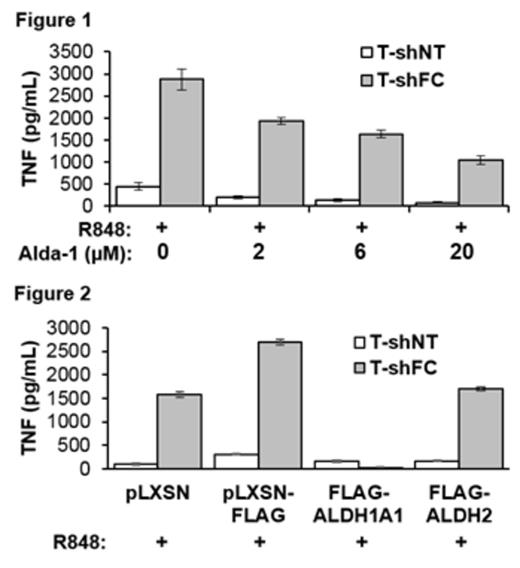Abstract
Replication and survival of FA-deficient hematopoietic stem and progenitor cells (HSPC) are highly suppressed by exposure to inflammatory cytokines including TNFα, IL-1β, IFNγ, and MIP-1α. Additionally, FA macrophages exposed to specific toll-like receptor (TLR) ligands overproduce the very inflammatory cytokines that exhaust the stem cell pool. Recent evidence using double knockout mice suggests that aldehyde dehydrogenases (ALDH) may play a role in protecting FA HSPC but the mechanisms involved are unclear. We tested the hypothesis that the TLR-dependent overproduction of inflammatory cytokines in FA macrophages results from a loss of FA protein-dependent ALDH function. Control (T-shNT) or FANCC-deficient (T-shFC) THP-1 human monocytic leukemia cells were treated with Alda-1 (a small molecule ALDH agonist known to enhance the activity of both ALDH1A1 and ALDH2), before exposing them to the TLR-7/8 agonist R848 and quantifying the production of TNFα (ELISA of 24- culture supernatants). While R848 alone induced a 6-fold increase in TNFα production by the FANCC-deficient cells, Alda-1 suppressed TLR-induced TNFα production in a dose-dependent manner, by both T-shNT and T-shFC cells (Fig. 1). To identify the ALDH isoform that played a role in the suppression of TNFα production, we ectopically expressed ALDH1A1 or ALDH2 in T-shNT and T-shFC cells. Overexpression of ALDH2 had little effect on R848-induced TNFα production, but ALDH1A1 overexpression completely suppressed TNFα production by FANCC-deficient cells and suppressed (by approximately 50%) the production of TNFα by control cells (Fig. 2). Likewise, in loss-of-function studies, siRNA knockdown of ALDH1A1 (but not ALDH2) enhanced R848-induced production of TNFα (1.8-fold) in T-shNT cells but did not enhance TNFα overproduction in either FANCC-deficient (T-shFC) or FANCA-deficient (T-shFA [FANCA knockdown]) cells. Additionally, ALDH1A1 (but not ALDH2) mRNA was highly inducible in both THP-1 cells (by R848) and in Lin- Sca-1+ Kit+ murine marrow cells (by TNFα). While ALDH1A1 mRNA is expressed similarly in both T-shNT and T-shFC cells, our results indicate that in normal macrophages ALDH1A1 plays a role in the constraining TLR-induced TNF production but is significantly less functional in FANCC-deficient macrophages. In summary, (1) either pharmacological enhancement of ALDH function with Alda-1 or overexpression of ALDH1A1 is sufficient to restore the TLR-suppressive function of ALDH1A1 in FANCC-deficient macrophages, and (2) specific suppression of ALDH1A1, (but not ALDH2) induces an FA-like phenotype in control macrophages. We conclude that (1) optimal function of ALDH1A1 is FANCC- and FANCA-dependent in normal macrophages, (2) TLR-dependent overproduction of inflammatory cytokines by FA-deficient macrophages may result either from an increase in aldehyde load or the loss of a non-canonical signal-suppressive function of ALDH1A1, and (3) enhancement of ALDH activity using small molecule agonists such as Alda-1 may alleviate the FA macrophage/cytokine phenotype and thereby protect HSC from inflammation-induced exhaustion.
No relevant conflicts of interest to declare.
Author notes
Asterisk with author names denotes non-ASH members.


This feature is available to Subscribers Only
Sign In or Create an Account Close Modal